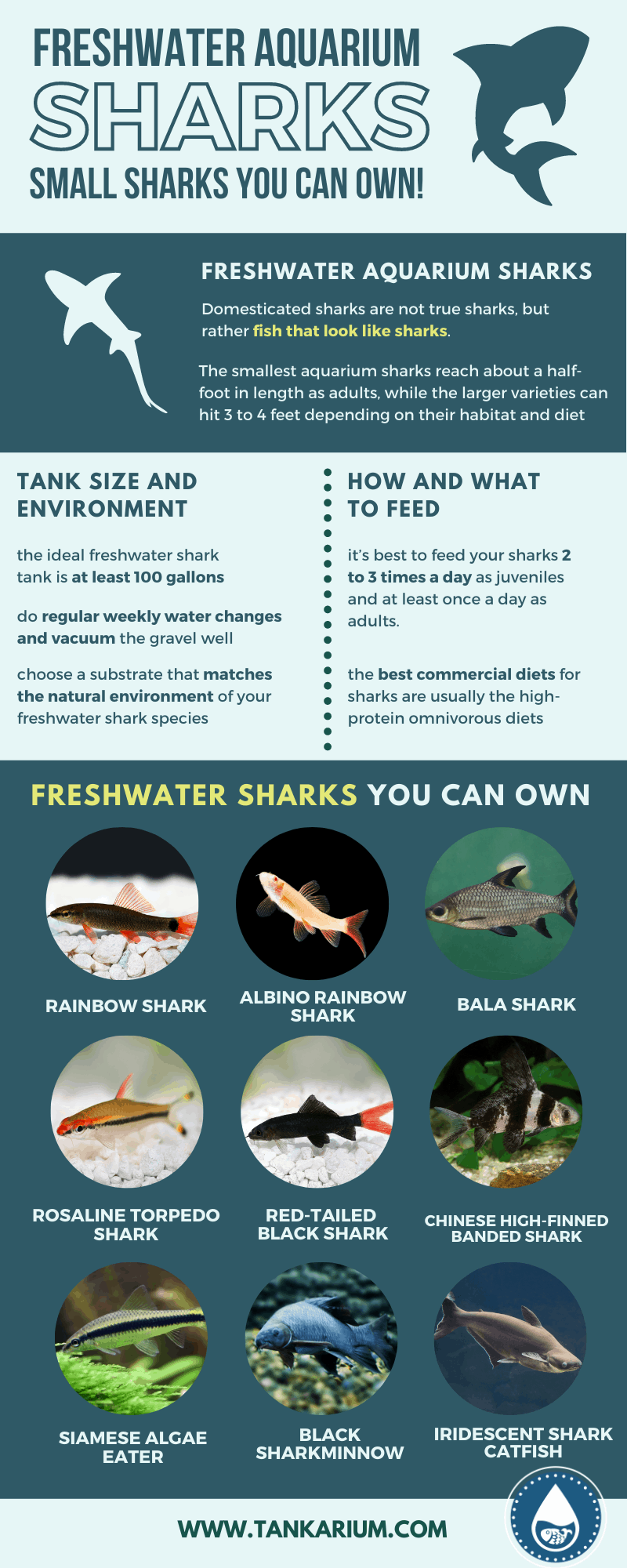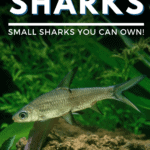Can you have a shark as a pet? While the ocean-swimming varieties are too large for hobby tanks, there are many types of pet sharks suitable for freshwater aquariums and ponds. We’ve rounded up the most popular species and created this detailed care guide to help you design the best tank for your freshwater aquarium sharks.
Freshwater Sharks You Can Own: 13 Small Sharks for Aquariums
Now that you know how to design the ideal shark tank and the details on their care and feeding, let’s take a look at the best small shark species for freshwater aquariums and ponds! This list of freshwater sharks includes some popular favorites of mine, as well as a few rare and extremely unique fish for advanced aquarists.
1. Rainbow Shark
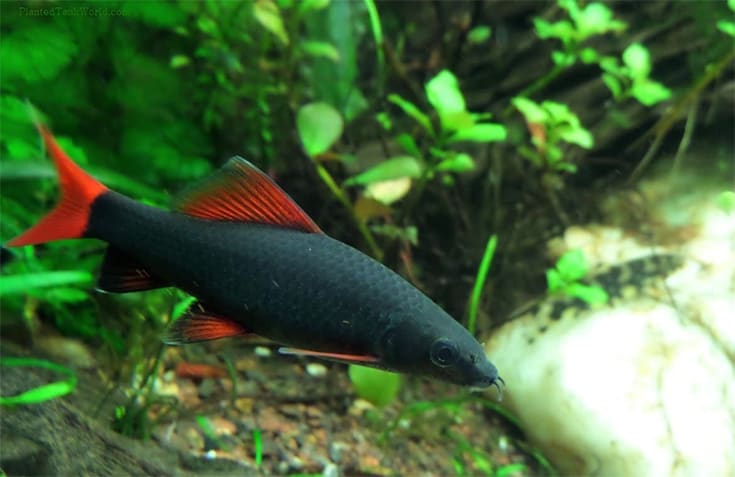
One of the most popular freshwater sharks is the stunning and entertaining bottom dweller known as the Rainbow Shark. With their long bodies and dark grey to black scales, their bright red fins really stand out among the plants and decorations in your tank. You’ll see why they are also known as the Ruby Shark.
Rainbow sharks are semi-aggressive and territorial, and need at least a 50-gallon set-up free from other bottom-dwelling species. They can be shy as juveniles but become more aggressive as they mature. They prefer a densely planted tank with some open areas for swimming, with plenty of rocks or logs to hide among. They are active during the day and always come out for feeding time.
Scientific Name
Epalzeorhynchos frenatus
Common Names
Rainbow Shark, Ruby Shark
Family
Cyprinidae
Temperament
Semi-Aggressive and Territorial
Care Level
Easy to Moderate
Minimum Tank Size
50 Gallons for 1; 125 Gallons for a group of 3
Maximum Adult Length
6 inches
Shark Color and Appearance
Dark grey to black body with orange/red colored fins and black eyes
Water Conditions
75 to 81°F; pH 6.5 to 7.5; 5 to 11 KH
Diet
Omnivore; enjoys a variety of flake, fresh, frozen and freeze dried treats
Compatible Tank Mates
Mid and upper level fish that don’t look like sharks and are too large to be eaten, such as Gourami, Barbs, Danios and Rainbowfish
2. Albino Rainbow Shark
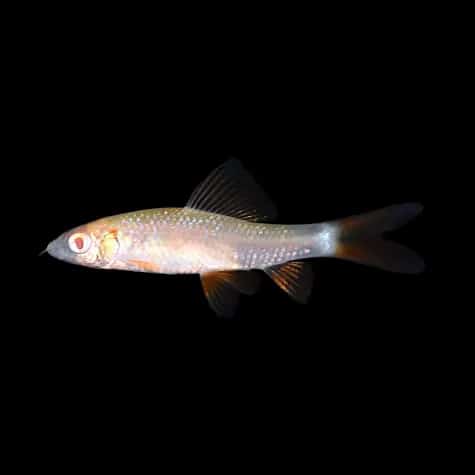
The Albino Rainbow Shark is a rare color morph that’s a pleasure to keep in a large planted tank. They are identical to the regular Rainbow in size and shape, but their bodies are white with pinkish highlights around their gills and abdomens. Their fins are a pinkish-orange color instead of being a vivid red. Their behavior and care requirements are the same as the regular Rainbow Shark, though.
Albinos look amazing as they scavenge through the substrate looking for food and chase other fish from their territories. They usually prefer a soft sandy bottom to prevent injury to their delicate scales, and enjoy swimming in fast currents along the bottom of your tank. If you’d like to keep more than one fish, you’ll need at least a 125-gallon shark tank so they each have room to establish their territory.
Scientific Name
Epalzeorhynchos frenatus
Common Names
Albino Rainbow Shark
Family
Cyprinidae
Temperament
Semi-Aggressive and Territorial
Care Level
Easy to Moderate
Minimum Tank Size
50 Gallons for 1; 125 Gallons for a group of 3
Maximum Adult Length
6 inches
Shark Color and Appearance
White body with pink/orange/red colored fins and a red/pink eyes
Water Conditions
75 to 81°F; pH 6.5 to 7.5; 5 to 11 KH
Diet
Omnivore; enjoys a variety of flake, fresh, frozen and freeze dried treats
Compatible Tank Mates
Mid and upper level fish that don’t look like sharks. Gourami, barbs, danios and rainbow fish
3. Bala Shark
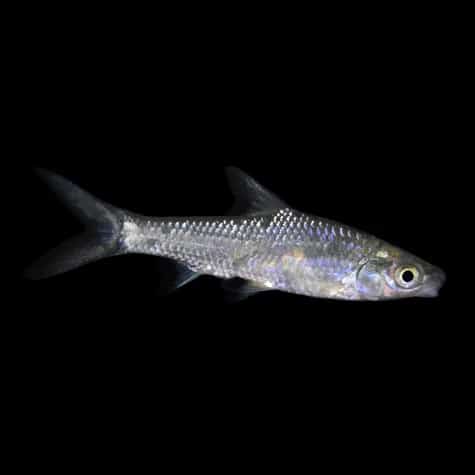
One of my overall favorite aquarium species is the beautiful Bala Shark. Don’t let their impressive black-and-yellow dorsal fin fool you into thinking they are mean! These sharks are peaceful community members as long as they are kept with fish large enough that they can’t be eaten.
Bala Sharks make a great addition to planted community tanks, and can sometimes be kept with other species of sharks as well. They enjoy schooling as a group in the middle of your tank and usually ignore bottom dwellers. They can grow up to a foot in length, however, so each shark needs at least 45 gallons of room. Leave plenty of open areas with a swift current for swimming, and your Bala’s will put on quite a show, especially during mealtimes!
Scientific Name
Balantiocheilus melanopterus
Common Names
Bala Shark, Silver Shark
Family
Cyprinidae
Temperament
Peaceful and Active
Care Level
Moderate
Minimum Tank Size
150 Gallons for a group of 3 (at least 45-gallons per shark)
Maximum Adult Length
12 inches
Shark Color and Appearance
Silver/grey body with distinct black and yellow striping on fins and large black eyes
Water Conditions
76 to 80°F; pH 6.5 to 8; not sensitive to hardness
Diet
Omnivore; high-protein flake or pellet diet supplemented with fresh/frozen bloodworms and brine shrimp
Compatible Tank Mates
Ideal for peaceful aquatic communities with large fish such as other Bala Sharks, Gourami, Rainbowfish, Corydoras and Tetras
4. Roseline Torpedo Shark
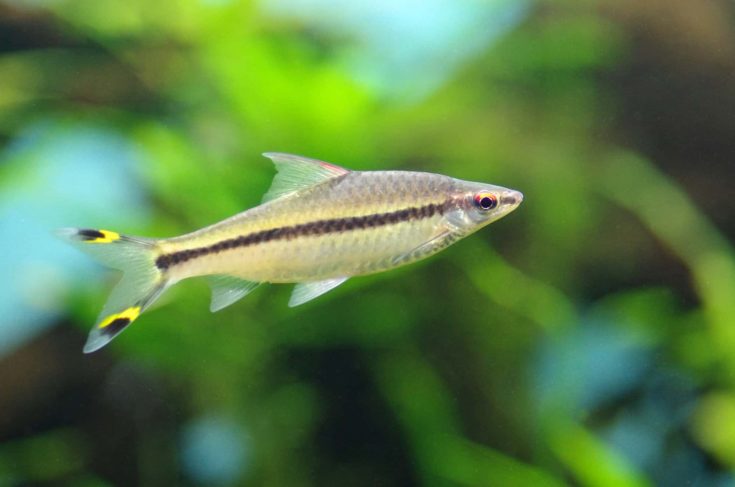
I’ve had Roseline Sharks in my community tanks for years and didn’t even know it. It turns out these sharks are more commonly known as the Denison’s Barb, which is the name I purchased them under. These flashy, active sharks love to school as a group in the middle of your tank, and their black and red stripes and yellow and black caudal and dorsal fins add a lot of color to your tank.
These active swimmers need clean and highly oxygenated water with plenty of open areas to school. They are best kept in groups of 6 or more, and often act out when kept in smaller numbers. They are messy eaters and often uproot plants, so heartier varieties like Anubis and Java Fern are ideal if you opt for a planted shark community.
Scientific Name
Sahyadria denisonii
Common Names
Rosaline Torpedo Shark, Denison’s Barb, Red-Line Torpedo Barb
Family
Cyprinidae
Temperament
Peaceful and Active
Care Level
Moderate
Minimum Tank Size
55 Gallons for a group of 6
Maximum Adult Length
6 inches
Shark Color and Appearance
Silver/grey body with a prominent black stripe running from the head to base of the tail and a red stripe above it running through the eye and partway down the body. Has a bright red dorsal fin and yellow/black stripes on the tips of the caudal fins
Water Conditions
60 to 77°F; pH 6.8 to 7.8; 5 to 25 dGH
Diet
Omnivore; Enjoys a wide variety of flake, pellet and fresh/frozen foods
Compatible Tank Mates
Best kept in schools of 6 or more with other large community fish such as Barbs, Danios, Tetras or Cichlids
5. Red-Tailed Black Shark
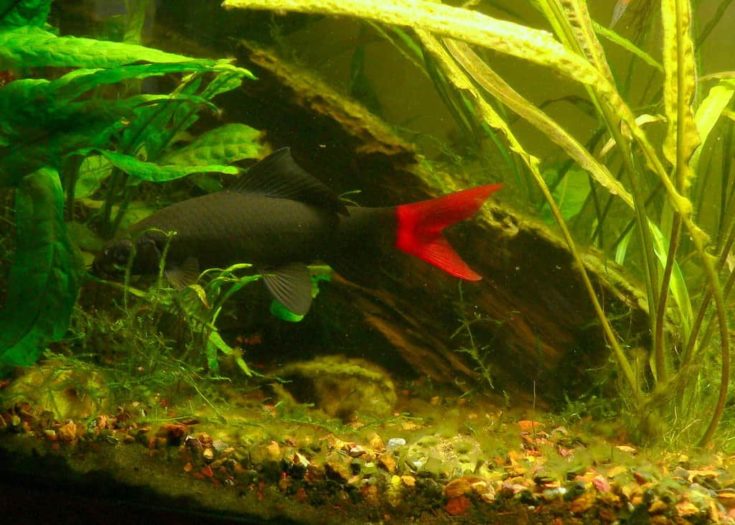
A distant relative of Rainbow’s is these stunning Red-Tailed Black Sharks. Their overall shape is similar to their cousins, but their scales and fins are a deep black color, which highlights their vivid red caudal fin (tail). These semi-aggressive bottom dwellers defend their territories and usually ignore the rest of the tank.
Red-Tailed Sharks are a little trickier to keep than Rainbows since they are slightly more aggressive towards other fish that enter their territories. But unlike Rainbows, they rarely target fish that stay in the middle of your tank. I’ve kept Red-Tails with Bala Sharks, for instance, but wasn’t able to do the same with Rainbows. You’ll want to be sure they are your only bottom-feeding fish to avoid problems with aggression.
Scientific Name
Epalzeorhynchos bicolor
Common Names
Red-Tailed Black Shark, Red-Tailed Shark
Family
Cyprinidae
Temperament
Semi-Aggressive and Territorial
Care Level
Moderate
Minimum Tank Size
55 Gallons per shark
Maximum Adult Length
6 inches
Shark Color and Appearance
Black body scales with vivid red caudal fins
Water Conditions
72 to 79°F; pH 6.8 to 7.5; 5 to 15 dH
Diet
Omnivore; Commercial flake and pellets, sinking algae wafers, fresh/frozen bloodworms, brine shrimp, or krill
Compatible Tank Mates
Large mid-level community fish such as Bala Sharks, Angelfish, Barbs, Danios, and Tetras
6. Harlequin Shark
Unlike the others I’ve profiled so far, the Harlequin Shark isn’t a peaceful or semi-aggressive species. They are highly aggressive and readily attack other species, even other Harlequin’s. These rare camouflaged bottom dwellers prefer densely planted tanks with few tank mates and a swift current. They are ideal for large single-species set-ups 55 gallons and up.
Harlequin Sharks should only be added to mature planted aquariums because they enjoy feeding on biofilm, which is a type of algae and bacterial mix that only accumulates in older tanks. These African carp live along river bottoms in the wild and thrive in tanks with a silty substrate and plenty of rocks, sticks, and branches to hide among. They resemble some of the showier plecostomus, with their cream-colored base overlaid by patches of dark grey or brown.
Scientific Name
Labeo cyclorhynchus
Common Names
Harlequin Shark; Harlequin Sharkminnow, Variegated Shark
Family
Cyprinidae
Temperament
Highly Aggressive
Care Level
Moderate to Advanced
Minimum Tank Size
55 Gallons
Maximum Adult Length
6 inches
Shark Color and Appearance
Cream base color covered with mottled patches of grey/brown
Water Conditions
72 to 81°F; pH 6.0 to 7.5; 3 to 15 dGH
Diet
Omnivore; Flake and sinking diets, fresh/frozen brine shrimp, bloodworms, and mosquito larvae along with plenty of vegetables such as algae wafers, blanched spinach, cucumbers, and chopped fruit
Compatible Tank Mates
Best kept in a single species tank or with a few large mid-level aquarium fish such as Barbs, Danios, or African Characins
7. Siamese Algae Eater (SAE)
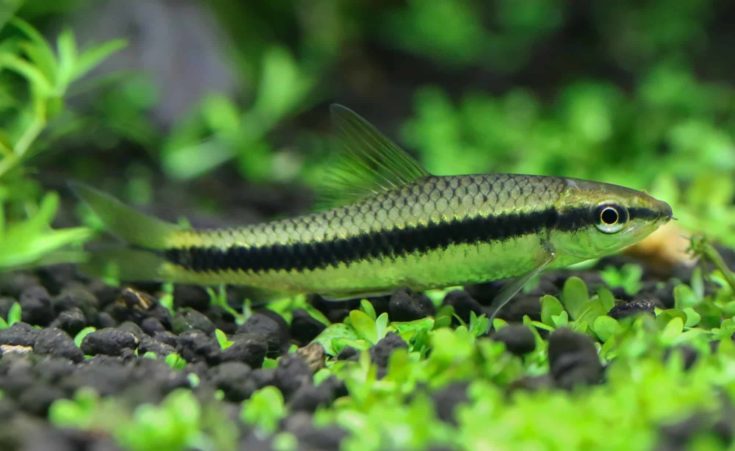
If you’d like an easy shark that makes a great addition to any peaceful aquarium community, then consider the Siamese Algae Eater (SAE). Not only do they resemble small sharks, with their long bodies and large upright dorsal fins, they are also one of the best algae eaters around. They are one of the few fish that will eat the dreaded black hair algae!
It’s not ideal to keep SAEs with long-finned or slow-swimming fish, such as Angelfish or Bettas, since they enjoy nipping at their fins. SAEs are a great option for active community tanks with a mix of planted and open areas, however, and are one of the few freshwater sharks that can live in a 20-gallon nano tank!
Scientific Name
Crossocheilus oblongus
Common Names
Siamese Algae Eater, SAE
Family
Cyprinidae
Temperament
Peaceful and Active; can nip at the tails of long-finned fish
Care Level
Easy
Minimum Tank Size
20 Gallons (add 10 gallons per SAE)
Maximum Adult Length
6 inches
Shark Color and Appearance
Pale grey to gold body scales with a black stripe running through the eye and down the center of the caudal fins
Water Conditions
75 to 79°F; pH 6.5 to 8; 5 to 20 KH
Diet
Omnivore; readily consumes aquarium algae, commercial flake, and pellet diets, but prefers live/frozen foods like brine shrimp, larvae, bloodworms, and Daphnia eggs
Compatible Tank Mates
Best kept with small-finned peaceful community fish like other SAE, Tetras, Barbs, Guppies, Gourami, and Corydoras
8. Black Sharkminnow
Another option for experienced aquarists with very large tanks is the amazing 2 to 3-foot-long Black Sharkminnow. These freshwater black sharks are highly aggressive and don’t do well in mixed or community tanks. They’ll quickly outgrow nearly every other fish in the community and would just end up eating them.
What type of tank do you need to raise these big black sharks? Like the Harlequin, they need a mature planted environment with swift currents and plenty of open areas to swim. Juveniles can be started in a roomy 125-gallon set-up but need at least a 200-gallon tank or heated pond when mature. A large tank with one of these monsters could be an impressive conversation piece in your home.
Scientific Name
Labeo chrysophekadion
Common Names
Black Sharkminnow, Black Laebo, Big Black Shark
Family
Cyprinidae
Temperament
Highly Aggressive
Care Level
Advanced
Minimum Tank Size
125 Gallons for juvenile and at least 200 Gallons for adult
Maximum Adult Length
24 to 36 inches
Shark Color and Appearance
Black body and fins
Water Conditions
76 to 82°F; pH 6.5 to 7.5; 10 to 15 KH
Diet
Omnivore; Enjoys eating aquarium algae but also needs a good commercial flake/pellet diet supplemented with plenty of live/frozen tubifex, bloodworms, brine shrimp, Daphnia, and veggies such as spinach, shelled peas, and cucumber
Compatible Tank Mates
Best kept solo as the only species in a mature planted tank
9. Iridescent Shark Catfish
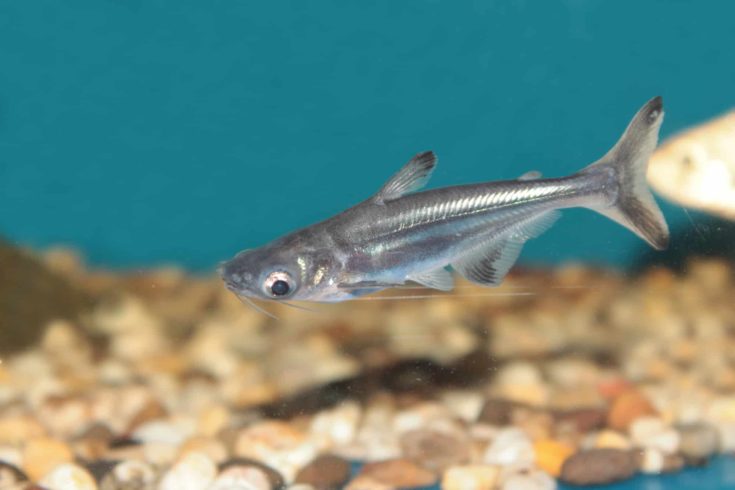
If you’d like a big domesticated shark for a tank that’s at least 300 gallons, then check out the lovely and peaceful Iridescent Shark Catfish. Also known as the Siamese Shark, these silver-colored fish have prominent barbels or whiskers around their mouths and can grow up to 4 feet in length!
The Iridescent is a difficult and challenging shark to keep in an aquarium long-term due to its size and activity and might do better in a heated outdoor pond. They can be reactive to the noise around their tanks and often panic and hurt themselves bashing into the glass. They are best kept with other similar-sized Iridescents or large community fish that prefer a sandy substrate and fast-flowing current.
Scientific Name
Pangasianodon hypophthalmus
Common Names
Iridescent Shark Catfish, Siamese Shark, Sutchi Catfish
Family
Pangasiidae
Temperament
Peaceful and Active
Care Level
Advanced
Minimum Tank Size
100 Gallons for juvenile; 300 Gallons per adult
Maximum Adult Length
48 inches
Shark Color and Appearance
Darker grey dorsal side shading to a pale grey or silver below the lateral line
Water Conditions
72 to 79°F; pH 6.5 to 7.5; 2 to 20 dGH
Diet
Omnivore; Readily eats commercial flake and pellet diets along with fresh/live foods
Compatible Tank Mates
Best kept with large and peaceful community fish or with other similar-sized Iridescent Sharks
10. Silver Apollo Shark
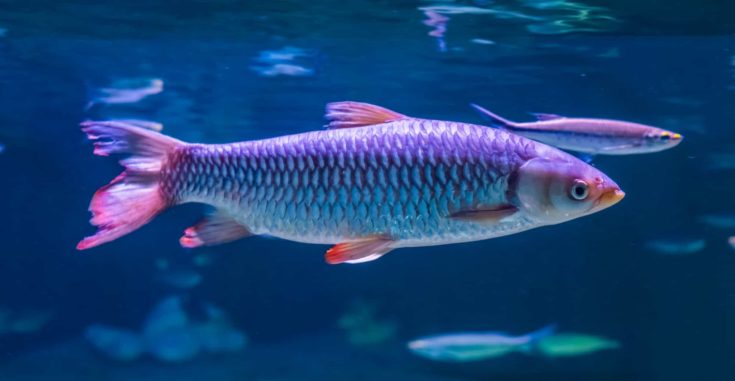
The Silver Apollo Shark is a rare fish that is often confused with its larger relative, the Long-Finned Apollo Shark (Luciosoma spilopleura). These peaceful fish have a pointed snout, unlike most freshwater sharks, and very short barbels or whiskers around their mouth. They prefer to swim in the middle and feed at the top of your tank.
You’ll need a large tank with a rapid surface current to raise these sharks, and they do best in groups of 3 to 12. You can keep Silver Apollo’s in a school with Bala Sharks if you’d like, which makes for a stunning display. Just be sure your tank has a tight lid because these sharks can easily jump out if there are any gaps.
Scientific Name
Luciosoma setigerum
Common Names
Silver Apollo Shark
Family
Cyprinidae
Temperament
Peaceful and Active
Care Level
Advanced
Minimum Tank Size
120 Gallons for a group of 3
Maximum Adult Length
8 to 9 inches
Shark Color and Appearance
Silver/grey body with a greenish tinge above the black lateral line that runs from their pointed snout to the upper edge of their forked caudal fins
Water Conditions
72 to 78°F; pH 6.0 to 7.5; 2 to 20 dGH
Diet
Omnivore; Commercial flake and floating pellets supplemented with live/frozen brine shrimp, bloodworms, krill and Mysis shrimp
Compatible Tank Mates
Best kept in schools of 3 to 12 along with large community fish such as Bala Sharks or Tin Foil Barbs
11. Violet Blushing Shark
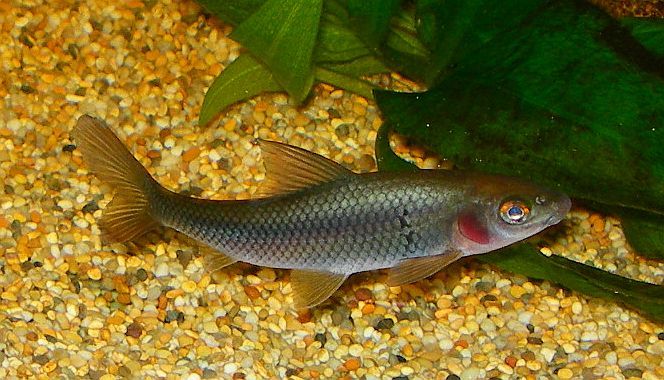
If you’d like a shark that looks different from the rest, these beautiful Violet Blushing Sharks could be the bottom feeder you’ve been looking for. Their transparent albino scales allow you to see their gills through the clear gill cover, which is why they are also called the Violet or Red Gilled Shark.
The Blushing Shark is a peaceful fish that doesn’t usually cause problems in your tank. They can get very large, almost a foot in length, so they are ideal for aquariums 125 gallons and up. You can keep a single shark, or raise a group of at least 5 in a larger tank. They don’t do well in smaller groups, but make a great solo or group addition to Rainbowfish and Loach tanks!
Scientific Name
Labeo boga
Common Names
Violet Blushing Shark, Violet Gilled Shark, Red Gilled Shark
Family
Cyprinidae
Temperament
Peaceful and Active
Care Level
Moderate to Advanced
Minimum Tank Size
125 Gallons
Maximum Adult Length
12 inches
Shark Color and Appearance
Transparent scales that appear pale pink to silver/white in color with noticeable pink/red gills seen through the clear gill cover
Water Conditions
68 to 78°F, pH 6.6 to 7.9
Diet
Omnivore; Prefers sinking foods like algae wafers and commercial catfish pellets and fresh/frozen treats like bloodworms, brine shrimp, mosquito larvae and blanched veggies
Compatible Tank Mates
Can be kept solo in community tanks with similar-sized Rainbowfish and Botiid loaches, or in single species tanks in groups of 5 or more
12. Columbian Shark
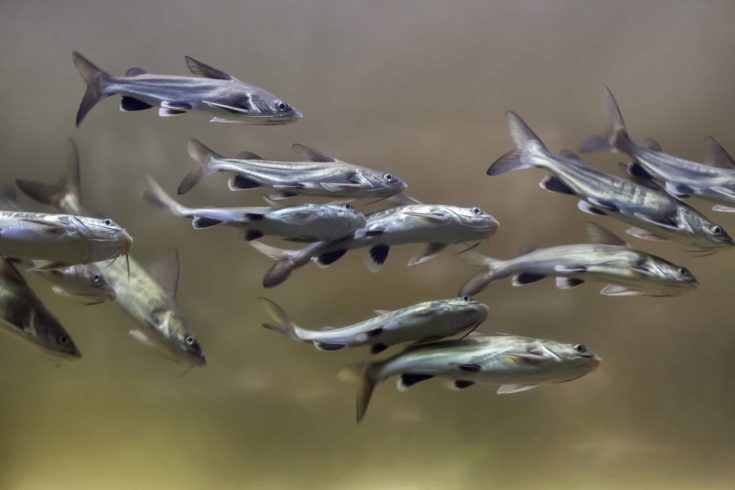
One of the coolest sharks for freshwater aquariums isn’t a freshwater fish at all. The Columbian Shark is a type of ocean catfish. They live in freshwater streams when young and migrate to the ocean when they mature. They need increasingly brackish water conditions as they grow, so you’ll have to add aquarium salt and manage your tank’s salinity levels.
They are best kept in groups with other Columbian sharks rather than as members of a brackish community since they prefer a higher salinity level once they reach maturity. These shifting water parameters make them one of the hardest aquarium fish to keep.
Scientific Name
Ariopsis seemanni
Common Names
Columbian Shark, Silver Tipped Shark, Black Finned Shark
Family
Ariidae
Temperament
Peaceful and Active
Care Level
Very Advanced
Minimum Tank Size
75 Gallons for 1; add 25-gallons per shark for groups
Maximum Adult Length
20 inches
Shark Color and Appearance
Silver/grey body shading to white below the lateral line with black and transparent fins. Prominent black dorsal fins have a venomous barb that can pierce flesh and cause pain and swelling!
Water Conditions
75 to 80°F; pH 7.0 to 8.0; 10 to 12 KH
Specific gravity shifts with age: 1.002 to 1.010 for juveniles, 1.020 to 1.025 for mature adults
Diet
Omnivore; Readily eats commercial flake and pellet diets along with fresh/frozen brine shrimp, bloodworms, krill, and insects like mosquito larvae
Compatible Tank Mates
Ideally kept as a group of three or more in a single species tank, but also works with similar-sized brackish fish such as Gobies, Green Chromides and Targetfish
13. Chinese High-Finned Banded Shark
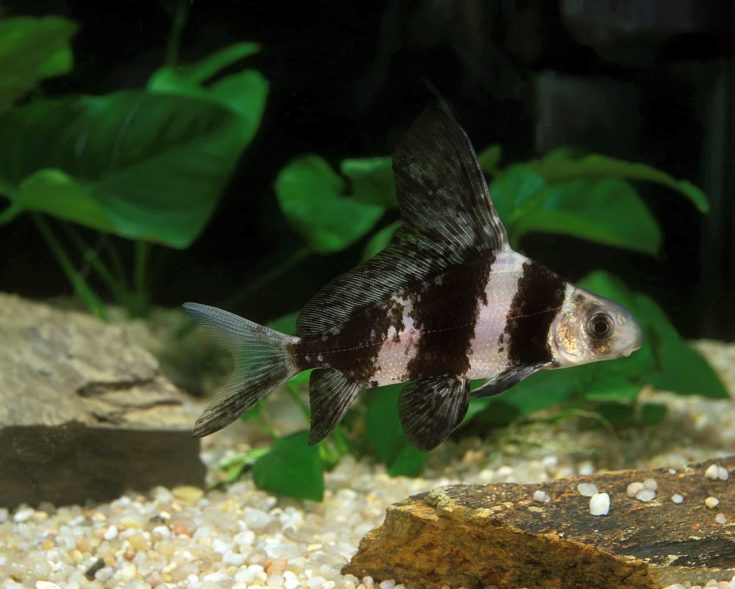
Our final shark is the rare and stunning Chinese High-Finned Banded Shark, also known as the Chinese Sailfin Sucker or Banded Loach. These peaceful and active fish can reach over 4 feet in the wild, but most aquarium fish stop growing at around 30 inches in length.
Unlike the other sharks on my list, the Chinese Banded is a coldwater species and is well suited to life in a pond. In fact, it’s better to transfer them to a pond as they mature, since they usually outgrow aquariums anyway. You can add these friendly fish to a koi or goldfish pond and they’ll help keep the algae under control too!
Scientific Name
Myxocyprinus asiaticus
Common Names
Chinese Banded Shark, Banded Loach, Chinese Sailfin Sucker
Family
Castomidae
Temperament
Peaceful and Active
Care Level
Advanced
Minimum Tank Size
100 Gallons per fish, but they do best if transferred to a pond at maturity
Maximum Adult Length
Can grow over 48 inches in the wild, but usually tops off at 30-inches in aquariums
Shark Color and Appearance
Brown body with three dark brown to black stripes running vertically from dorsal fin to anal fin. Elongated and upright dorsal fin is prominent in juveniles but shrinks in maturity
Water Conditions
60 to 75°F; pH 6.8 to 7.5; 4 to 20 dGH
Diet
Omnivore. Feed commercial sinking catfish pellets and algae wafers. Can supplement with fresh blanched veggies like spinach, broccoli, and peas and fresh/frozen Daphnia and bloodworms
Compatible Tank Mates
Best kept in a school of 3 to 5 fish in your aquarium and then transferred to a pond with similar-sized koi, goldfish, and loaches
Guide to Freshwater Sharks for Fish Tanks
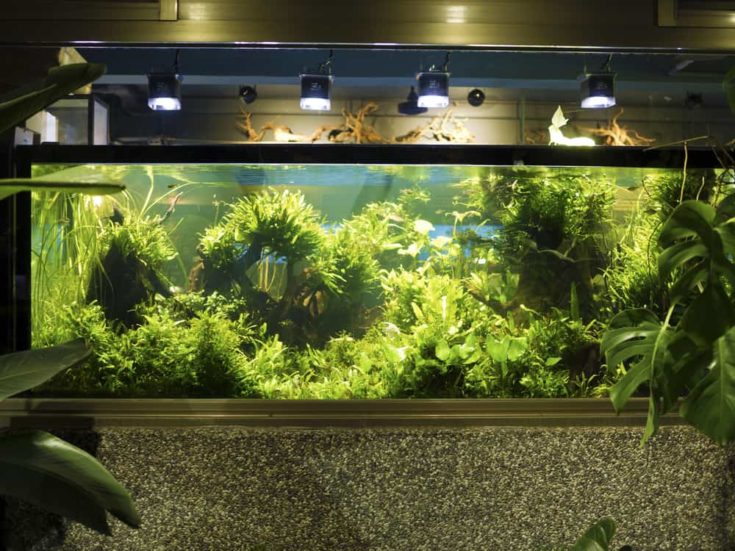
If you’re a fan of Shark Week, then you should consider getting pet sharks for your home aquarium. These predatory fish are fascinating to watch and make for an active and lively aquatic display. How are pet mini sharks different from the large saltwater varieties, and what kind of tank and care do they require?
What is a Freshwater Aquarium Shark?
Domesticated sharks are not true sharks, but rather fish that look like sharks. There’s a wide variety of sharky-appearing fish that make great aquarium pets, and some are even ideal for community tanks! These small freshwater shark species share some similarities with each other:
- Mini sharks have long, torpedo-shaped bodies and prominent, upright dorsal fins. It’s common to see deeply forked caudal fins (tails) on freshwater sharks as well.
- They are usually members of the catfish or carp families and act as omnivorous scavengers, eating plant materials like algae and other animals.
- Sharks are typically active and entertaining pets that enjoy swimming in strong currents, and many species will school together if kept in a group.
What Size Are Freshwater Sharks?
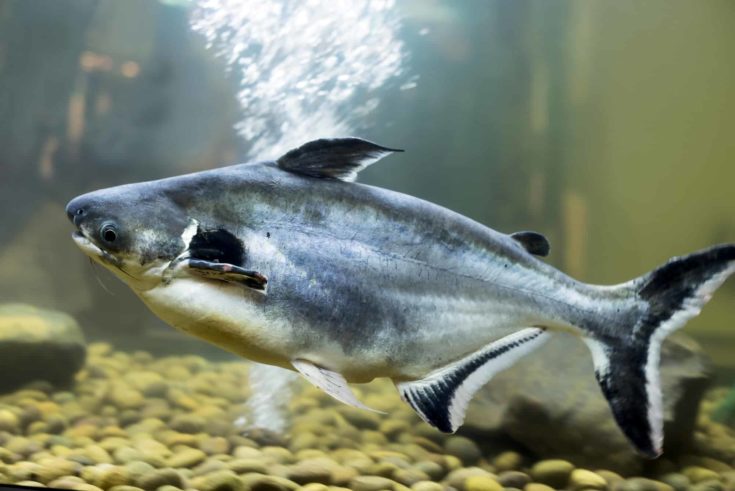
Pet sharks for home aquariums are usually sold as juveniles when they are a few inches in length, and may take several years to reach their full size. It’s easy to underestimate how much they might grow, so always take into account their maximum adult size range when designing your shark tank.
The smallest aquarium sharks reach about a half-foot in length as adults, while the larger varieties can hit 3 to 4 feet depending on their habitat and diet. Aquarium sharks rarely reach their maximum size if kept in cramped conditions and fed a poor-quality diet.
How to Set Up a Shark Aquarium
There’s a lot of questions that come up when you’re looking to set up a shark tank. How big of a tank do you need for a shark, and what kind of filtration system do they prefer? Here are the key requirements for designing a stellar freshwater shark aquarium!
Tank Size and Environment
Most freshwater sharks are native to fast-flowing streams and rivers and need plenty of space for swimming. They usually do best in long-style tanks rather than cubes or portrait shapes. Bottom-dwelling sharks also like to have rocks, caves and plants to explore, while mid-level and surface sharks prefer open tanks with fewer decorations.
In terms of capacity, the ideal freshwater shark tank is at least 100 gallons:
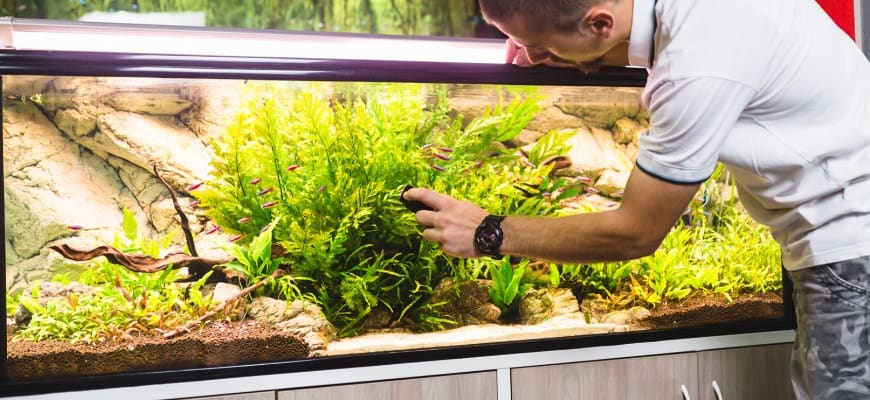
- There are few shark species that can thrive in 20 to 55-gallon tanks as long as there aren’t too many fish; the ideal numbers vary depending on the species.
- While you can temporarily raise juveniles in smaller set-ups, there aren’t any varieties of sharks small enough for 10-gallon tanks as adults.
- A few types of freshwater sharks are more suited to pond life than an aquarium at maturity, unless you have a tank that’s 300 to 500 gallons.
Filtration and Water Requirements
One thing all freshwater shark species have in common is a sensitivity to their water conditions. It’s important to do regular weekly water changes and vacuum the gravel well to remove decaying materials. If you want to have healthy predatory fish:
- Sharks need very fresh, filtered water free from any detectable ammonia or nitrates.
- Weekly water changes and regular filter maintenance and media replacement are needed to keep the tank clear of decaying materials that can cause nitrogen spikes.
- They also need stable water parameters, so you’ll have to maintain a steady water temperature and test the pH regularly to avoid problems.
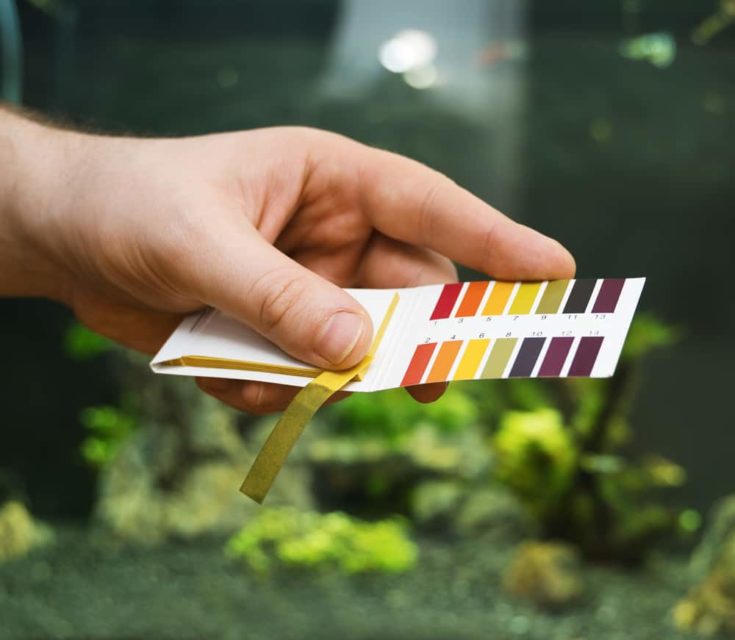
You should definitely invest in a top-notch aquarium filter that can handle a high flow rate. Sharks enjoy swimming in strong currents and prefer highly oxygenated water. For most shark tanks, a canister filtration system is an ideal choice, since it’s easier to direct the outflow to generate strong currents than with a HOB-style filter.
In terms of temperature, the majority of freshwater sharks are tropical fish that need their water maintained in the 70 to 80°F range. You’ll need a heater for most shark tanks, although there are a few coldwater sharks that don’t need supplemental heat and do well in pond environments.
Substrate
It’s usually best to choose a substrate that matches the natural environment of your freshwater shark species. Many of these fish are bottom dwellers in the catfish family, and have delicate barbels or whiskers that could be injured on sharp rocks or gravel. Soft sand is ideal for most shark tanks, but some species do well with gravel too.
How and What to Feed Your Freshwater Shark
Unlike their big carnivorous cousins in the ocean, freshwater sharks are omnivorous scavengers who’ll eat anything they can fit into their mouths. They are usually not picky about their diets, either. Your sharks will eat smaller fish and invertebrates like shrimp just as readily as they’ll eat commercial diets and algae.
How Often Should You Feed Your Shark?
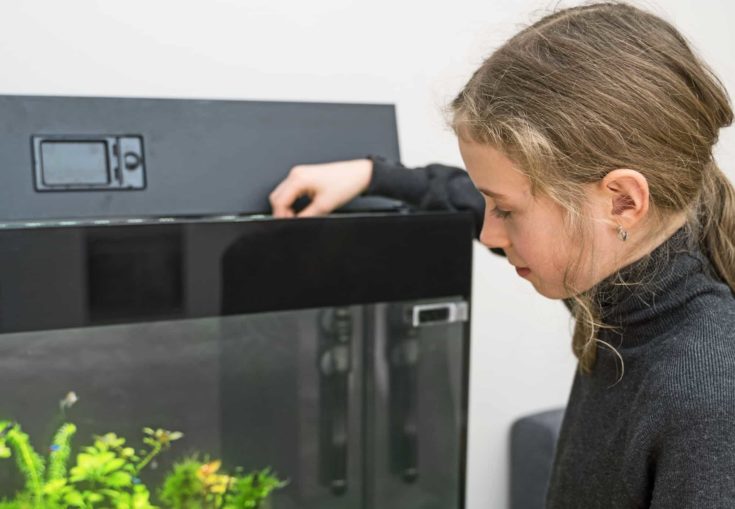
With their voracious appetites, it’s best to feed your sharks 2 to 3 times a day as juveniles and at least once a day as adults. The exact amounts will vary, of course, but you should limit it to what they can consume in about 2 to 3 minutes and promptly remove any leftovers.
What’s the Best Diet For Freshwater Sharks?
The best commercial diets for sharks are usually the high-protein omnivorous diets made for catfish, goldfish and koi.
- For bottom-feeding shark species, sinking pellets or wafers are ideal since they naturally fall to the bottom of the tank where your shark hangs out.
- Formid-level and surface-feeding sharks, floating flake or pellet diets are perfect since they remain in the water column for a while.
The best treats depend on your species of shark, but should include a mix of high-protein live/frozen foods and vegetable products. Some options include:
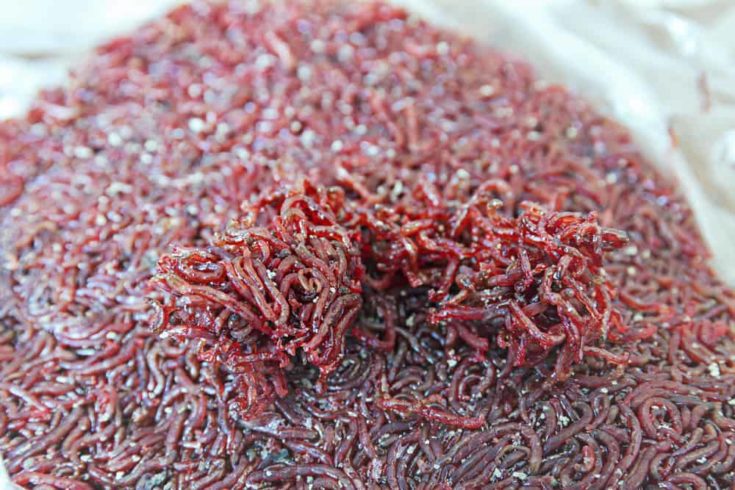
- Brine shrimp, mysis shrimp, krill, and other crustaceans.
- Bloodworms, tubifex worms, and earthworms.
- Insects, larvae and eggs, such as mosquito larvae andDaphniaeggs or fry.
- Algae wafers, spirulina granules and sinking veggie pellets.
- Fresh blanched green veggies such as spinach, cucumber, zucchini and peas.
Conclusion
As you can see, when it comes to sharks you can own, you’ve got a lot of options no matter your tank size or aquatic experience. Freshwater sharks make great pets and add a lot of color and activity to your fish tank. Tell us about your Shark Tank! Drop a note in the comments or join the fun on our social media sites.
Check out our infographic and don’t forget to share!
